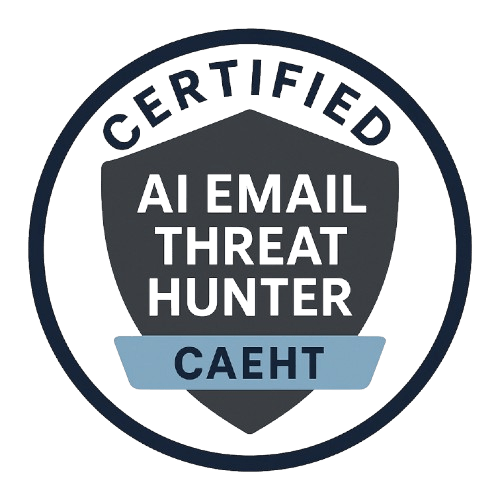
In today’s digital age, email remains one of the most commonly exploited attack vectors by cybercriminals. From phishing and spoofing to ransomware and business email compromise (BEC), organizations are increasingly vulnerable to sophisticated email-based threats. As traditional security solutions struggle to keep up, businesses are turning to artificial intelligence to provide faster, smarter, and more adaptive threat detection. This is where the Certified AI Email Threat Hunter (CAEHT) course becomes indispensable.
The AI Email Threat Hunter is the modern cybersecurity professional equipped with advanced AI tools, real-time analytics, and contextual threat intelligence to proactively detect, investigate, and neutralize email-borne threats before they cause harm. Whether you're part of a Security Operations Center (SOC), an IT security team, or a managed service provider, this certification course will prepare you to lead email threat hunting strategies using cutting-edge artificial intelligence technologies.
The Certified AI Email Threat Hunter (CAEHT) program is designed for those ready to move beyond reactive spam filters and into the world of proactive, AI-driven cybersecurity. This isn’t just another certification, it’s a practical, real-world training program that empowers professionals to hunt, analyze, and defeat evolving email threats with confidence and precision. You’ll gain hands-on experience with real data, simulated threat environments, and case studies that demonstrate how AI is transforming email security from static rule sets into dynamic, intelligent threat response systems.
Starting from foundational concepts in email threat landscapes and AI threat detection techniques, the course progresses toward advanced threat hunting tactics, machine learning-driven detection models, and SOC-level threat mitigation workflows. By the end of the course, you’ll be fully capable of designing, deploying, and managing an AI-enhanced email threat hunting strategy that adapts to evolving attack vectors in real time.
As an AI Email Threat Hunter, your responsibilities will span far beyond detection. You’ll understand how to interpret anomalies, link indicators of compromise (IOCs), perform forensic email header analysis, evaluate the integrity of metadata, and deploy natural language processing (NLP) models to detect social engineering patterns. You'll use AI not just as a tool, but as a teammate, working alongside human intelligence to deliver accurate, scalable protection against malicious actors.
This course also aligns closely with frameworks such as MITRE ATT&CK®, NIST Cybersecurity Framework, and ISO/IEC 27001 controls. It’s ideal for cybersecurity analysts, IT administrators, threat hunters, incident responders, and AI-curious professionals who want to become the vanguard of intelligent email defense.
The Certified AI Email Threat Hunter (CAEHT) designation enhances your professional credibility and opens doors to specialized roles within cybersecurity, including Email Security Analyst, AI Threat Intelligence Officer, and SOC Automation Specialist. As organizations increasingly rely on cloud communications and digital correspondence, the demand for professionals who can protect these systems with precision is skyrocketing.
Whether you're defending a financial institution, a government agency, or a technology startup, the skills gained in this course will enable you to act swiftly, think algorithmically, and respond surgically to the threats lurking in every inbox.

https://thecasehq.com/courses/certified-ai-email-threat-hunter-caeht/?fsp_sid=3065
Comments
Post a Comment